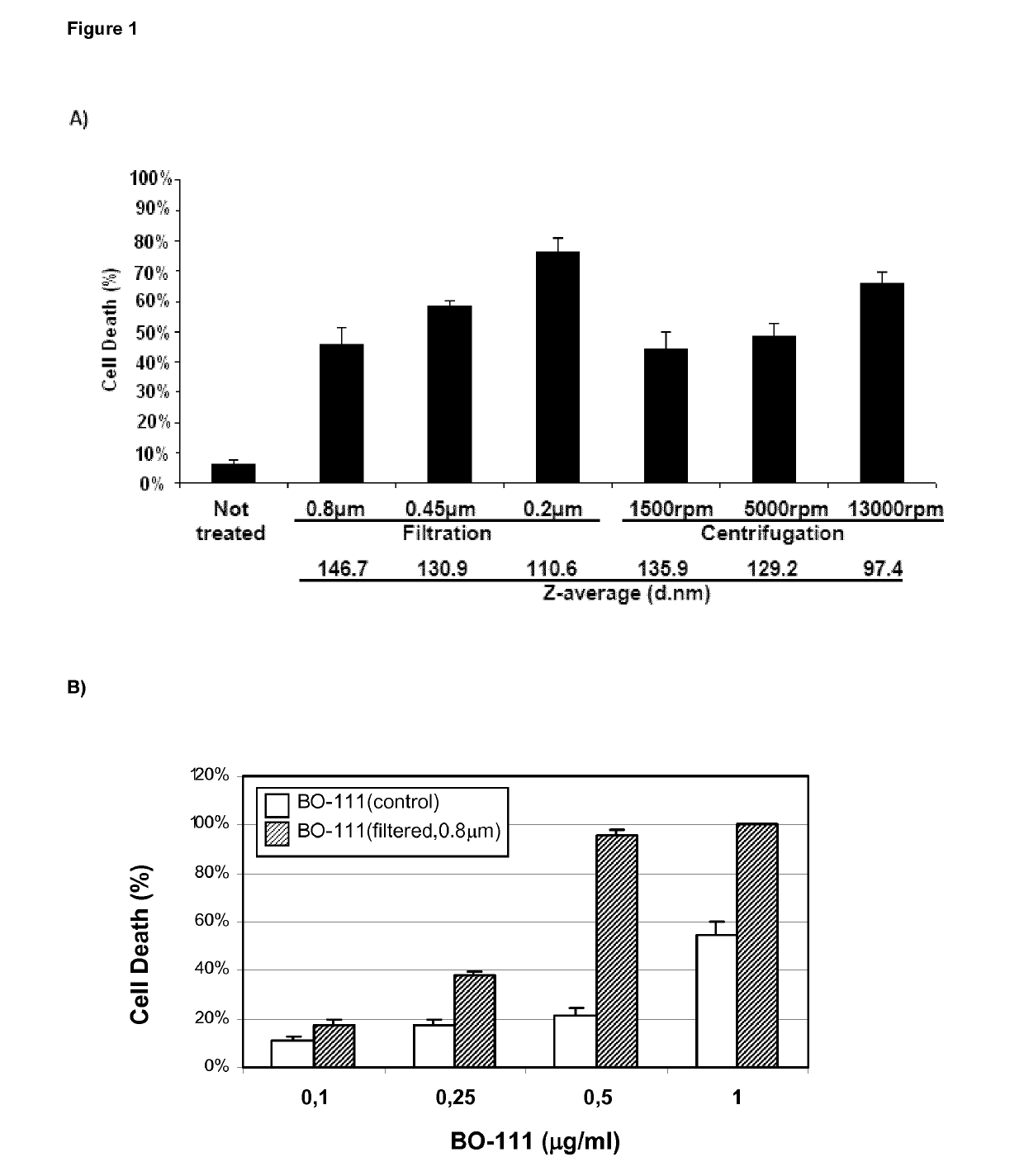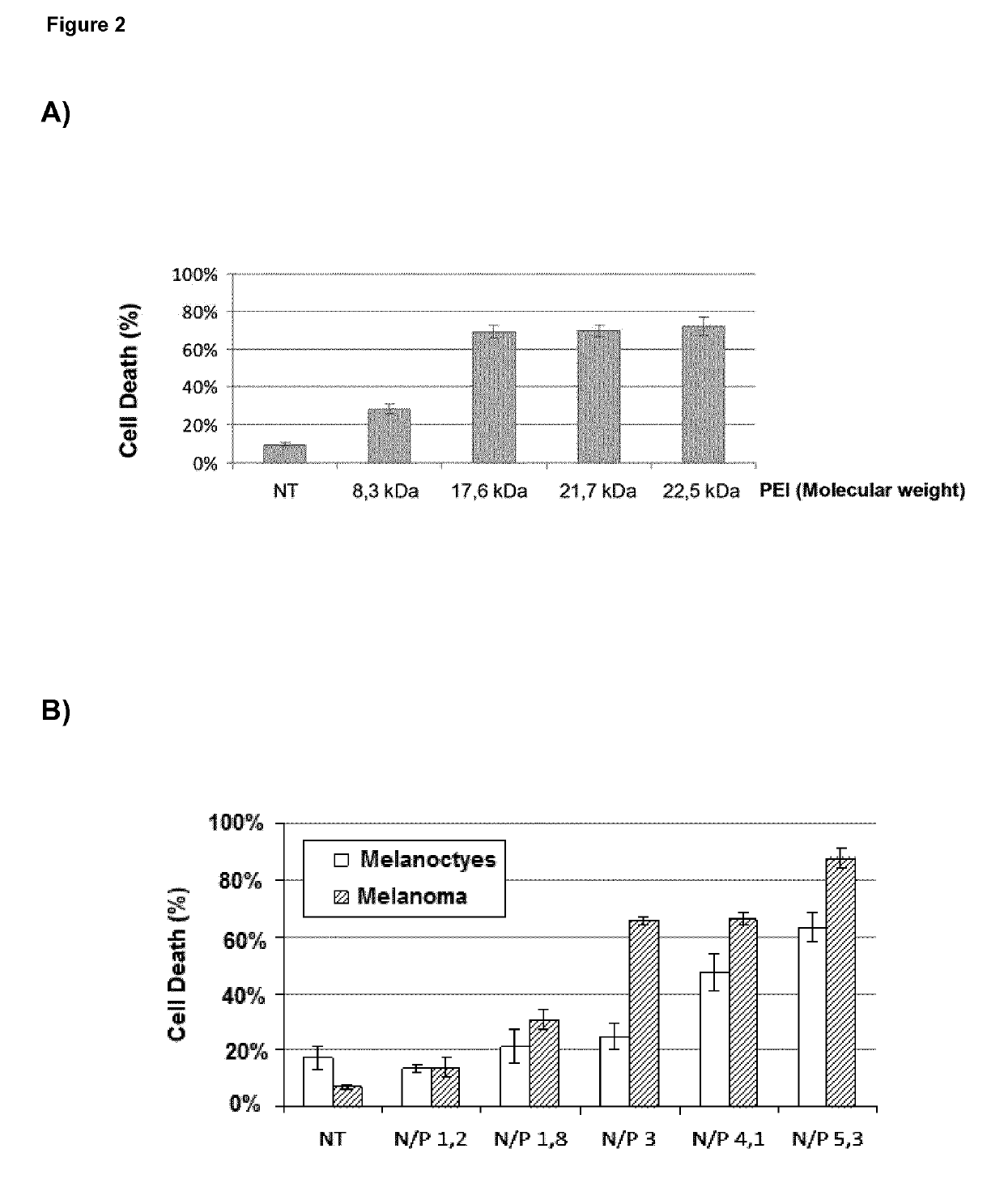Pharmaceutical composition comprising particles comprising a complex of a double-stranded polyribonucleotide and a polyalkyleneimine
a polyalkyleneimine and polyribonucleotide technology, applied in the direction of drug compositions, peptides, immunoglobulins, etc., can solve the problems of poor or unconfirmed preclinical evidence, poor homogeneity, and low stability
- Summary
- Abstract
- Description
- Claims
- Application Information
AI Technical Summary
Benefits of technology
Problems solved by technology
Method used
Image
Examples
example 1
f Complex-Size on Anticancer Effects of Distinct JetPEI-Based Poly(I:C) Preparations (BO-111 Formulations)
Materials & Methods
BO-111 Formulations (2-Vial Process)
The single-stranded polyinosinic acid [poly(I)] and polycytidylic acid [poly(C)] molecules that were used for generating double-stranded polyinosinic-polycytidylic acid [poly(I:C)] molecules] were obtained from commercial providers such as Tide Group, Carbogen or Invivogen. Depending from the provider and the batch, the size distribution for poly(C) molecules is defined as being: <400 bases, 20-82% (with further tests performed using preparations presenting, for instance, 33%, 43%, or 50%); 400-850 bases, 15-40% (with further tests performed using preparations presenting, for instance, 27%, 30% or 37%); 850-5000 bases, 3-50% (with further tests performed using preparations presenting, for instance, 13%, 30% or 34%); >5000 bases, 1% or less (generally absent). Depending from the provider and the batch, the size distribut...
example 3
l Characterization of BO-11X Preparations in Cell-Based Models
Materials & Methods
Poly(I:C) Formulations
The poly(I:C) preparations have been obtained as described in Example 2.
Analysis of Cell Viability
The human melanoma cell line SK-MEL-103 and human pancreatic cancer cell line PANG 02.03 have been used as described in Example 1 and the literature that is cited herein, using the poly(I:C) formulations at concentrations that contain poly(I:C) molecules in a range between 0.3 and 2.5 μg / mL (0.85 μg / mL being the most relevant reference value) and exposing cells for a period comprised between 12 and 48 hours.
The death-inducing activity of BO-112 was tested in normal melanocytes and cell lines from melanoma and glioblastoma and compared to isolated components, i.e. poly(I:C) molecules and linear PEI (Jet PEI; Polyplus). Normal melanocytes were isolated from foreskins of asymptomatic donors. Melanoma cells SK-Mel-28, SK-Mel-103, and UACC62 (with mutations in p53, NRAS and BRAF respectivel...
examples 1 and 2
show experimental data about the initial development and characterization of BO-11X formulations, leading to increased cytotoxicity of BO-11X formulations against cancer cells as compared to BO-110. These data can be further integrated by comparing the BO-11X manufacturing process and resulting poly(I:C)-containing preparations with the processes and preparations that are disclosed in the literature.
PUM
| Property | Measurement | Unit |
|---|---|---|
| average molecular weight | aaaaa | aaaaa |
| average molecular weight | aaaaa | aaaaa |
| z-average diameter | aaaaa | aaaaa |
Abstract
Description
Claims
Application Information
 Login to View More
Login to View More - R&D
- Intellectual Property
- Life Sciences
- Materials
- Tech Scout
- Unparalleled Data Quality
- Higher Quality Content
- 60% Fewer Hallucinations
Browse by: Latest US Patents, China's latest patents, Technical Efficacy Thesaurus, Application Domain, Technology Topic, Popular Technical Reports.
© 2025 PatSnap. All rights reserved.Legal|Privacy policy|Modern Slavery Act Transparency Statement|Sitemap|About US| Contact US: help@patsnap.com



